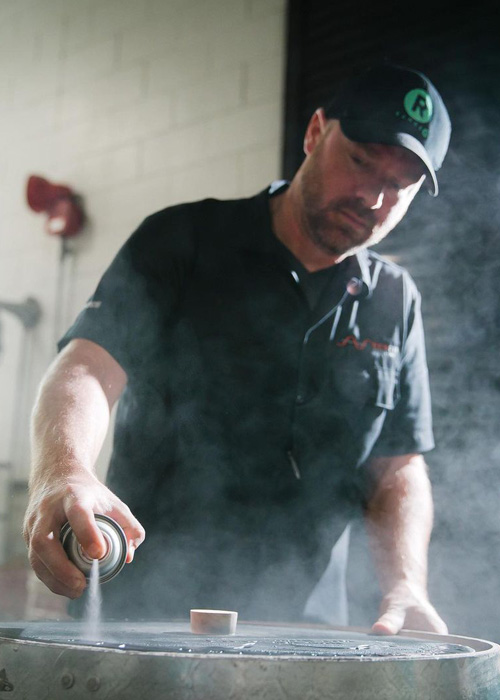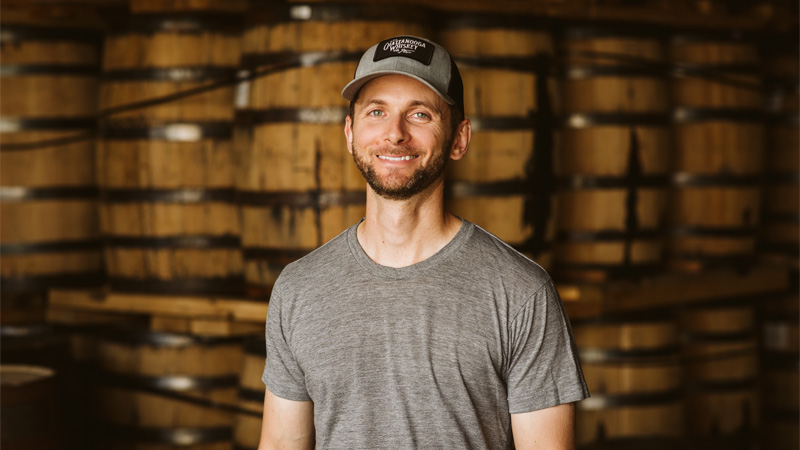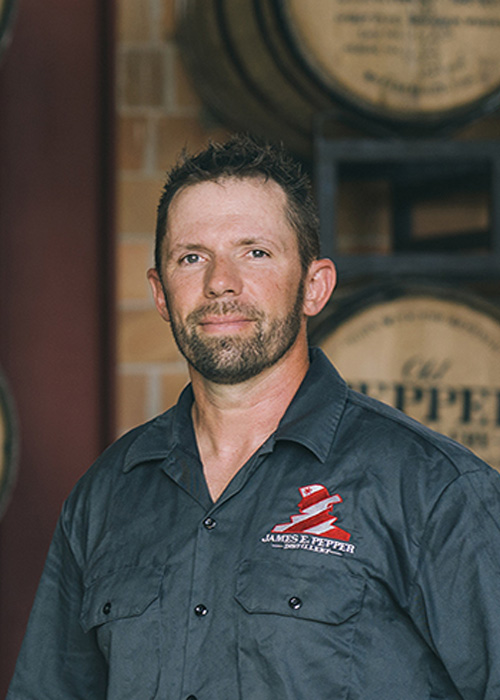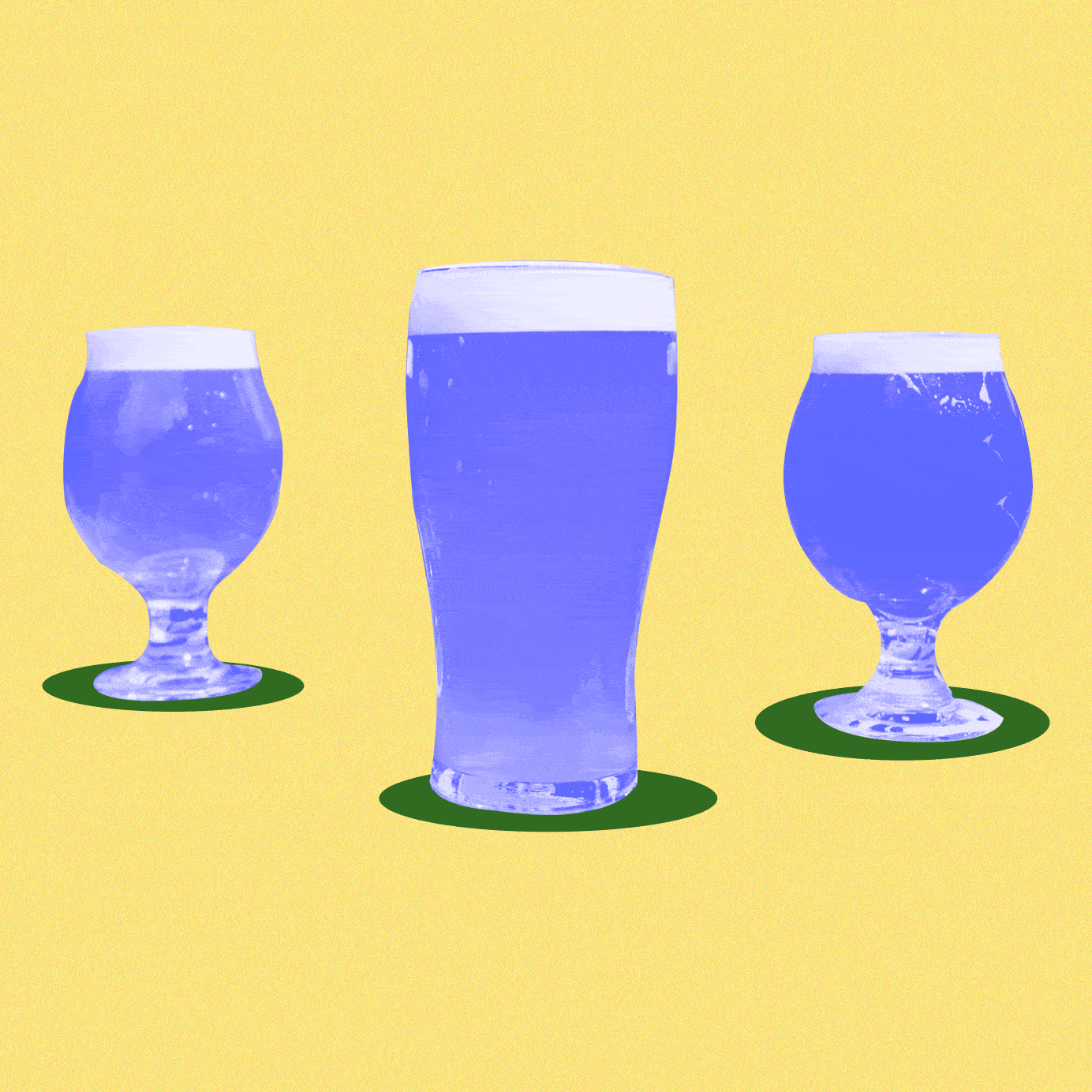Yes, another city may be in the company’s name, but a sizable chunk of Boston Beer Company’s beer is brewed in Cincinnati. It’s the hometown of Jim Koch, the craft beer pioneer’s always-smiling founder, and since 1994, many Samuel Adams beers have been produced in the Over-the-Rhine neighborhood, about three miles north of the Ohio River.
Drive southeast on West Liberty Street and down I-471 until you cross the Daniel Carter Beard Bridge, and less than 10 minutes later you’ll be in northern Kentucky — specifically, the town of Newport. There stands New Riff, one of the best craft whiskey makers in the business, which, oddly enough, employs a former Boston Beer Co. brewer as its head distiller.
“I know distilling looks like the sexy thing,” says Brian Sprance, who has held the position since New Riff was founded in 2014. “But all you are doing is magnifying all the flavors you created in fermentation.”
Other craft breweries seem to be catching on. Rather than strictly recruiting people with distilling experience, they’re bucking industry traditions by turning breweries — especially the Cincinnati outpost of Sam Adams — into a bit of a trade school for future whiskey makers.

That Brewery Mindset
At age 21, Sprance started in beer as a delivery driver for one of the Queen City’s first brewpubs, BarrelHouse Brewing Company. He eventually rose to become a brewer, but Sprance claims that what he primarily learned there was how to clean tanks (this will become important). After a change of ownership in 2008, he hopped to Boston Beer, just three blocks away.
“There weren’t really a lot of other options around,” he explains.
Now, I’m not going to claim that Boston Beer gives brewers some sort of secret sauce that turns them into incredible distillers. But, you take one of the biggest breweries in America, which necessitates a know-how in fermenting a wide range of things (lagers, big stouts, cider, hard tea, spiked seltzer, etc.) mixed with a uniquely close location to the whiskey hotbeds of Kentucky and Tennessee — plus a pinch of aggressive non-compete clauses — and you get a breeding ground for potential distillers.
At BarrelHouse, Sprance worked on a 15-barrel system, brewing a maximum of 4,500 barrels of beer per year. At Boston Beer, he was immediately thrown into the fire, with America’s second-biggest craft brewery producing millions of barrels per annum. Early on, he wasn’t really hands-on with the brewing, as he mostly learned the “hard-core technical” aspect of large-scale beer-making. (Ultimately, that was a good thing for his current profession.) He ended up working at Boston Beer for six years before eventually getting burned out.
“Honestly, I was sick and tired of being in beer,” says Sprance, who was just 36 at the time. He also had an 18-month non-compete agreement, meaning he couldn’t go to another brewery in town even if he wanted to. So he wasn’t quite sure what to do until a brewer friend of his working at nearby Ei8ht Ball Brewing, told him that his boss, Ken Lewis, was looking to start his own distillery. Sprance didn’t really even really drink whiskey at the time, but, he was told, Lewis was looking for someone with “a small-brewery mindset and skills at running a bigger brewery.”
Lewis had actually been tasked with finding someone with that unique curriculum vitae by Larry Ebersold, the legendary former master distiller for Seagram’s and then MGP. At the time, Ebersold was consulting for Lewis to help him optimize his processes and get the new distillery up and running. He told Lewis that, sure, he could just go to one of Kentucky’s major “heritage” distilleries and throw some money at an assistant distiller with years of factory experience. But, Ebersold felt that would just be hiring a guy or gal who was already locked in with one major brand’s own preconceived methods, distilling beliefs, and feelings on “what whiskey should taste like.”
Do that, and you would be creating nothing more interesting than a craft facsimile of a whiskey that everyone had already tasted before. Instead, Ebersold believed the way to make something truly new and innovative — a “new riff” on whiskey, if you will — was to pursue a brewer with a long history of fermentation expertise. In other words: a brewer.
“I’d been working with dozens of yeasts and making 80 different beers a year at Sam Adams,” explains Sprance. “Thankfully, that was what they were looking for.”
While craft beer fans and natural wine enthusiasts can’t stop talking about yeast’s role in the flavor of their favorite adult beverage, yeast is readily ignored by whiskey drinkers. That might be because yeast is rarely touted among the major Kentucky distilleries aside from Four Roses, which uses five different yeasts that the company believes impart a variety of flavors, from delicate fruit to slight spice to herbal notes.
True, most distilleries like Wild Turkey and Jim Beam claim they’ve been using the same “proprietary” yeast since their founding, but that always seems to be more for marketing purposes. (“[T]his isn’t just any old yeast,” claims the Jim Beam website. “It’s a very specific old yeast — the same strain we’ve been using since the end of Prohibition in 1933.”) Yeast is even more ignored in Scotland, where many Scotch distilleries supposedly use the exact same packets of “industrial” yeast.
Although, to be fair, it’s not like Sprance is claiming his years in beer had compelled him to employ something avant garde.
“For yeasts, it’s nothing fancy, it’s not like I sat under an apple tree to capture some,” he jokes. He’s more concerned with how it creates alcohol and flavor. “I embrace technology, so I went with the biggest, hungriest yeast I could find.”
He likes the predictability of using dry yeast, while at the same time embracing what he calls the “controlled chaos” of open fermentation. In the beer world, that process is more often used to create wild beers, sour beers. In the whiskey world, it’s just making the mash a little funky, injecting some lactic acid, and creating a ton of flavor before it’s distilled.
Sprance says he wants his bourbon mash to taste like an ester-exploding saison, while his rye mash should taste like two-day-old rye bread. If the mash isn’t on point, then there’s nothing that distilling or aging can do to improve it — clearly something that a lot of other craft whiskey distilleries don’t seem to understand.

Rules Are Good, Change Them
In 2014, Tim Piersant and Michael Robinson, the entrepreneurs behind Chattanooga Whiskey, an upstart in Tennessee, paid a visit to New Riff to check out the operations. They were hoping to create something similar. Ebersold just so happened to be in that day and, yet again, recommended they also go the route of hiring a brewer.
This time, Sprance knew the perfect person for the job: his buddy Grant McCracken. Sprance had hired him to work at Sam Adams in 2009 as a technician, making Angry Orchard cider and Twisted Tea. For the latter, McCracken claims it was essentially like creating a distillate without distillation, a super-light beer purified via adsorption through ion separation columns.
“Although it tasted like diluted vodka, it could legally still be considered a malt beverage,” explains McCracken who, unlike Sprance, was a whiskey drinker at the time. “It wasn’t the sexiest stuff in the world, making something taste like nothing, but it was extremely interesting, and it taught me some concepts that I’d eventually expound upon in distilling.”
Eventually, McCracken’s skills started turning heads within the company and he was asked to run an R&D nano-brewery within Sam Adams’ Boston pilot brewery, which he did starting in 2012. There, McCracken created a ton of high-ABV, barrel-aged beers, including some that tasted like whiskey or Cognac. These fermentations were so strong, in fact, that they naturally created a small amount of distillate out of the top arm of the fermenter.
He was enjoying the process so much that, on his own dime, he began to pursue certification through the Institute of Brewing & Distilling out of London. He, too, had a non-compete for the beer industry and wanted to have a backup plan just in case. Literally a week after finishing the certification, he got the call from Sprance, saying Chattanooga was looking for a brewer.
“One of their tag lines [on the company’s website], ‘Rules are Good, Change Them,’ really spoke to me,” says McCracken, who would be hired by the distillery at the end of 2014. “To me, it meant you can appreciate the traditions that come before you, but it’s our duty to challenge them and attempt to make them better.”
If there’s been a long-standing belief that craft whiskey would get good “just as soon as it was old enough,” New Riff and Chattanooga would quickly debunk that. Their whiskeys aren’t great because they are well aged (New Riff’s stuff is aged about four years, Chattanooga’s only two at this point), they are good because they’re creating new riffs and changing the rules — because their former brewer distillers are coaxing out tons of flavor before distilling ever occurs.
“You don’t make flavor in a still,” says Ebersold. That’s the key reason he recommended hiring these brewers.
It’s eye-opening, and soon makes you realize why some of these longtime craft whiskeys are never going to age into greatness: because they were probably never good before being distilled, and certainly not before they were put in the barrel.
You can’t help but wonder: What if distilleries should have been hiring professional brewers all along?

Finding Holes
“There are some similarities [between brewing and distilling], but it’s starkly different from what people believe,” says Aaron Schorsch, James E. Pepper’s master distiller. He should know, having made his bones in both the distilling and brewing worlds before landing his current job at the Lexington, Ky., distillery, some 83 miles south down I-75 from Sam Adams.
Growing up in small-town Indiana, the big Seagram’s plant in Lawrenceburg (now known as MGP) was one of the better jobs in the area. Schorsch started there in 1997, rolling barrels, and worked his way up the ladder over a decade (and, yes, even working under Ebersold for a while). Eventually, at age 30 with one kid and another on the way, he realized he could make more money at the very same Sam Adams Brewery in Cincinnati. He began work there in 2007 as a brewing supervisor, often working in a similar unit as Sprance, and quickly noticed something a lot of drinkers don’t really think about.
“Both industries are hyper-focused on being clean,” he claims. But cleanliness is even more critical in the brewing world, where a little unwanted bacteria can infect and then ruin an entire batch — a massive amount of money down the drain at a place like Boston Beer. Shorsch has taken that same fastidious attitude to James E. Pepper in a way that, he feels, many of the big breweries don’t, or might not even be capable of. “If you have clean equipment and you keep things sterilized, you just get better fermenations,” he says.
Shorsch explains that unwanted bacterial growth can creep into the pipes and affect flavors by making the fermentation prematurely sour, while likewise screwing up the overall yield. He notes that it’s easier for craft distilleries to be clean, as they inherently have smaller pipes to deal with than mega-distilleries.
Experimentation is also a key feature in the craft beer world these days, with many breweries producing more than 100 different beers per year. These whiskey makers have brought the same ethos to their distilleries. Sprance estimates he has already made 25 to 30 different whiskeys, a huge number for such a young operation. More critical is how he has played with variables, altering mash bills and grain usage, constantly making tweaks, always analyzing his data like he did at Sam Adams.
“I think there are natural creative limitations to focusing on just one craft your entire life,” says McCracken. “You start to lose the ability to find holes. Holes in the logic, holes for creative expression.”
From the beginning, McCracken claims, Chattanooga was told by numerous industry veterans that they should pick a proven mash bill, and in four years or so they’d have a decent bourbon. But that didn’t compute with McCracken, who thought there were more opportunities to create flavor, especially via malts, which are way more diverse in the beer world with each style calling for different types, whether a lightly kilned Vienna malt in pilsners or roasty chocolate malt in stouts and porters.
“From day one, we thought malt would give us the most freedom and range to express whiskey in the way we wanted,” McCracken explains. “When we use the word ‘malt,’ it’s more like using the word ‘spice’: a generic term to describe something that’s not necessarily generic in flavor.”
If most traditional distilleries might use a mere 5 to 15 percent malted barley in their mash bills, delicately flavored and mostly to aid in fermentation, Chattanooga uses four grains and three malts (malted rye, caramel malt barley, and honey malt barley) which comprise a whopping 25 percent of the mash bill.
Throw in additional techniques borrowed from brewing — long fermentation times, lower fermentation temperatures — and an incredible amount of flavor is created well before distilling occurs. There’s a reason Chattanooga calls its bourbon Tennessee High Malt; it’s showing that the distillery is creating a product that’s categorically different from those of all the other distilleries.
All the other distilleries run by … distillers.
“I think coming from another industry, not just brewing, provides a fresh but relevant perspective,” says McCracken. “If you sit too close to something, you can forget the bigger picture of what you’re actually looking at, and what makes it beautiful.”
This story is a part of VP Pro, our free platform and newsletter for drinks industry professionals, covering wine, beer, liquor, and beyond. Sign up for VP Pro now!
